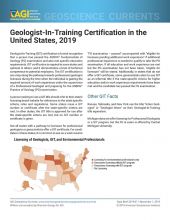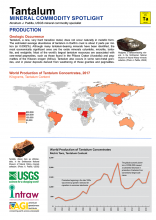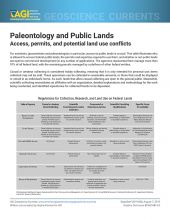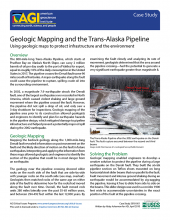How a few industrial minerals supply a vital transportation service
Background
In areas prone to winter precipitation, transportation infrastructure must be able to quickly respond to snow and ice on roadways. Ice removal is a vital service in these communities. Deicing chemicals melt ice by lowering the temperature at which it melts. They can also prevent new ice from forming and improve traction. Salt (sodium chloride) is a popular deicing chemical because it is cheap and abundant. Geoscientists help to find and mine salt and other industrial minerals that help keep our roads safe.
Salt consumption in the United States, 1940-2014. Domestic salt production quadrupled from 1940 to 1970, owing in large part to the adoption of road salt deicing practices on the new Interstate Highway System[3]. Data source: U.S. Geological Survey
Salt
The most common deicing method is the use of sodium chloride in the form of crushed rock salt, which is inexpensive, abundant, and easy to mine, store, distribute, and apply. Salt brines are increasingly used in some areas, but the vast majority is still rock salt. Present-day deposits of rock salt were formed by widespread evaporation of ancient inland seas.4 Rock salt deposits are geographically diverse, but consumption of rock salt is concentrated in the Great Lakes region (see map on reverse). Rock salt used for deicing may contain other chloride minerals in addition to sodium chloride (see next page).
Top rock salt producing (yellow) and consuming (blue) states in 2014. Top 3 producing states: LA (32%), NY (27%), OH (24%). Top 3 consuming states: NY (13%), OH (12%), IL (11%). Data source: U.S. Geological Survey[2]
Drawbacks & Limitations of Salt
- Chemical limitations. Sodium chloride cannot effectively melt ice below 10°F (-12.2°C).3
- Saltwater runoff can contaminate surface and groundwater, and damage soils, plants, and crops.5 Too much sodium in drinking water can be a concern for people who require low-sodium diets.5
- Corrosion. Salt eats away at metals used in bridges, buildings, and automobiles.
Other deicing materials & their sources
- Calcium chloride – commonly used; works above -20°F.5 Made by reacting sodium chloride with calcium carbonate, largely from the central and eastern U.S.6
- Magnesium chloride –works above 5°F.5 Domestic production capacity was 300,000 metric tons in 2015; 99% of domestic production is extracted as brine from Utah's Great Salt Lake.7
- Potassium chloride – works above 20°F.5 About 460,000 tons were produced domestically in 2015, largely refined from potassium ores mined in New Mexico and Utah.8
- Acetates – Potassium acetate works above -15°F, calcium magnesium acetate above 20°F.5 Acetates do not corrode metal but do damage concrete.9 They are biodegradable but can affect oxygen levels in lakes.5
- Sand – does not melt ice, but provides traction and helps to mechanically break up ice. Not all states use sand, but roughly nine million tons of sand were used for snow and ice control on U.S. roadways in 2015.10
Just the numbers (2014)
Salt in the U.S. (million metric tons)1
- Consumption: 56.5
- Production: 45.3
- Imports: 20.1
- Exports: 0.94
Rock salt (million metric tons)2
- Consumption: 27.9
- Consumption for roadway deicing: 24.5
- Domestic production capacity: 22.9
- Top producing states*:
- Louisiana: 7.3
- New York: 6.3
- Ohio: 5.4
- Top consuming states:
- New York: 3.6
- Ohio: 3.5
- Illinois: 3.0
- National average price per ton: $48.11
- 42% of total salt consumption
Total cost of rock salt used for roadway deicing. $1.18 billion#
* Based on reported production capacities of industrial salt producers
# 24.5 million tons at $48.11 per ton
Different forms of salt
Rock salt: solid masses of salt crystals that form rocks made almost entirely of salt. Mostly used in roadway deicing.
Brine: Salt-rich liquid, either extracted directly from salt lakes/salty groundwater, or by dissolving salt in water. Mostly used in the chemical industry.
More Resources
- Mineral Commodity Summaries and Minerals Yearbooks, published annually by the U.S. Geological Survey, provide global statistics and information for over 90 minerals and materials. These resources are freely available online at https://minerals.usgs.gov/
- New Hampshire Department of Environmental Services - Environmental, Health, and Economic Impacts of Road Salt
- AGI Critical Issues Program - Industrial Minerals
References
1 Mineral Commodity Summaries 2016, Salt, U.S. Geological Survey
2 Minerals Yearbook 2014, Salt, U.S. Geological Survey
3 Special Report 235: Highway Deicing, National Research Council
4 The Material Flow of Salt, U.S. Department of the Interior
5 Environmental, Health, and Economic Impacts of Road Salt, New Hampshire Department of Environmental Services
6 Mineral Commodity Summaries 2016, Stone (Crushed), U.S. Geological Survey
7 Minerals Yearbook, 2015, Magnesium Compounds, U.S. Geological Survey
8 Mineral Commodity Summaries 2016, Potash, U.S. Geological Survey
9 Physical and Chemical Effects of Deicers on Concrete Pavement, Utah Department of Transportation
10 Mineral Commodity Summaries 2016, Sand and Gravel (Construction), U.S. Geological Survey

This work is licensed under a Creative Commons Attribution-NonCommercial-NoDerivatives 4.0 International License.
You are free to share or distribute this material for non-commercial purposes as long as it retains this licensing information, and attribution is given to the American Geosciences Institute.

![Salt consumption in the United States, 1940-2014. Domestic salt production quadrupled from 1940 to 1970, owing in large part to the adoption of road salt deicing practices on the new Interstate Highway System[3]. Data source: U.S. Geological Survey Graph of salt use (total vs. use for deicing) in the United States over time](https://www.americangeosciences.org/sites/default/files/Salt-factsheet-figure-1.png)
![Top rock salt producing (yellow) and consuming (blue) states in 2014. Top 3 producing states: LA (32%), NY (27%), OH (24%). Top 3 consuming states: NY (13%), OH (12%), IL (11%). Data source: U.S. Geological Survey[2] Map of major salt-producing and salt-using states.](https://www.americangeosciences.org/sites/default/files/Salt-factsheet-figure-2.png)





